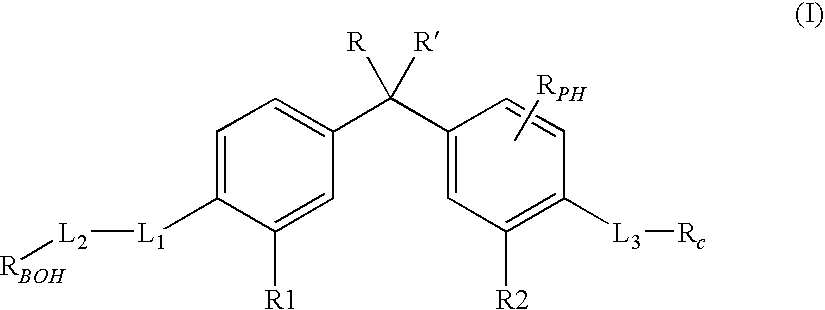Vitamin D receptor modulators
a technology of vitamin d receptor and modulator, which is applied in the field of ligand-dependent transcription factors, can solve the problems of insufficient separation to allow oral administration, hampered use of conventional vdr ligands, and inability to restore lost bone structure,
- Summary
- Abstract
- Description
- Claims
- Application Information
AI Technical Summary
Benefits of technology
Problems solved by technology
Method used
Image
Examples
example 1
Preparation of 2-(4-{1-Ethyl-1-[4-(1-hydroxy-cyclopentylethynyl)-3-methyl-phenyl]-propyl}-2-methyl-benzoylamino)-2-methyl-propionic acid
[0506]
A. [E,Z]-3-(3-Methyl-4-hydroxyphenyl)-3-pentene
[0507]
[0508]A mixture of 3-(3-methyl-4-hydroxyphenyl)-3-pentanol (20.0 g, 102.9 mmol), pTSA monohydrate (50 mg, 0.26 mmol catalytic amount), cyclohexane (150 mL), and toluene (250 mL) is refluxed on a steam bath for 3 h. During the reflux time, water is separated by means of a Dean-Stark trap. Analysis of the reaction mixture by TLC (SiO2; CHCl3) shows a spot to spot transformation of the starting material into a less polar material. The cyclohexane-toluene solution is cooled to RT, washed with satd sodium carbonate solution (25 mL), MgSO4 dried, and concentrated to give the title compounds as a [E:Z] isomeric mixture of [4:1] (17.36 g, 96%).
[0509]H-NMR (300 mHz, DMSO-d6): δ 6.85-7.10 (3H, m), 5.56 (0.8H, q, J=6.8 Hz), 5.39, 0.2H, q, J=6.8 Hz), 2.40 ((1.6H, q, J=7.6 Hz), 2.25 (0.4H, q, J=7.6 Hz), ...
example 2
Preparation of 2-(4-{1-Ethyl-1-[4-(3-ethyl-3-hydroxy-pent-1-ynyl)-3-methyl-phenyl]-propyl}-2-methyl-benzoylamino)-2-methyl-propionic acid
[0548]
A. 4-{1-Ethyl-1-[4-(3-ethyl-3-hydroxy-pent-1-ynyl)-3-methyl-phenyl]-propyl}-2-methyl-benzoic acid methyl ester
[0549]
[0550]4-[1-Ethyl-1-(4-ethynyl-3-methyl-phenyl)-propyl]-2-methyl-benzoic acid methyl ester (2.50 g, 7.47 mmol), lithium hexamethyldisilazide (8.22 ml, 8.22 mmol, 1.0 M in THF) and 3-pentanone (870 μL, 8.22 mmol) are reacted and purified analogous to Example 1H to give the title compound (2.22 g, 71%).
[0551]1NMR (400 MHz, CDCl3) δ ppm: 7.79 (d, 1H, J=7.9 Hz), 7.27 (d, 1H, J=8.6 Hz), 7.04-6.98 (m, 2H), 6.95 (s, 1H), 6.91 (dd, 1H, J=8.0, 1.9 Hz), 3.86 (s, 3H), 2.54 (s, 3H), 2.36 (s, 3H), 2.13-1.98 (m, 8H), 1.94-1.72 (m, 5H), 0.59 (t, 6H, J=7.3 Hz).
B. 4-{1-Ethyl-1-[4-(3-ethyl-3-hydroxy-pent-1-ynyl)-3-methyl-phenyl]-propyl}-2-methyl-benzoic acid
[0552]
[0553]4-{1-Ethyl-1-[4-(3-ethyl-3-hydroxy-pent-1-ynyl)-3-methyl-phenyl]-propyl}-2-meth...
example 3
Preparation of (4-{1-ethyl-1-[4-(2-ethyl-2-hydroxy-butoxy)-3-methyl-phenyl]-propyl}-2-methyl-benzoylamino)-acetic acid
[0564]
A. 3′,3′-Bis[4-hydroxy-3-methylphenyl]pentane
[0565]
[0566]To a mixture of o-cresol (196 g, 1.81 mol) and 3-pentanone (60 ml, 0.57 mol) is added methanesulfonic acid (45 ml, 0.69 mol) and stirred for 3 days. The reaction is basified to pH 8 with satd Na2CO3 and extracted with EtOAc. The organic layer is washed with water (6×500 ml), Na2SO4 dried, concentrated, chromatographed (2 kg SiO2, Hex to 80% EtOAc / Hex), and triturated with Hex to give the title compound as a white solid (100 g, 61%).
[0567]NMR 400 mHz(DMSO): δ 0.49 (t, J=7.3 Hz, 6H), 1.91 (q, J=7.3 Hz, 4H), 2.02 (s, 6H), 6.61 (d, J=8.3 Hz, 2H), 6.73 (d, J=8.3 Hz, 2H), 6.76 (s, 2H), 8.94 (s, 2H).
[0568]High Res. EI-MS: 284.1794; calc. for C19H24O2: 284.1776
B. 3′-[4-Benzyloxy-3-methylphenyl]-3′-[4-hydroxy-3-methylphenyl]pentane
[0569]
[0570]To a solution of 3,3-bis[4-hydroxy-3-methylphenyl]pentane (10 g, 35.2 mm...
PUM
| Property | Measurement | Unit |
|---|---|---|
| temperature | aaaaa | aaaaa |
| pH | aaaaa | aaaaa |
| weight percent | aaaaa | aaaaa |
Abstract
Description
Claims
Application Information
 Login to View More
Login to View More - R&D
- Intellectual Property
- Life Sciences
- Materials
- Tech Scout
- Unparalleled Data Quality
- Higher Quality Content
- 60% Fewer Hallucinations
Browse by: Latest US Patents, China's latest patents, Technical Efficacy Thesaurus, Application Domain, Technology Topic, Popular Technical Reports.
© 2025 PatSnap. All rights reserved.Legal|Privacy policy|Modern Slavery Act Transparency Statement|Sitemap|About US| Contact US: help@patsnap.com



